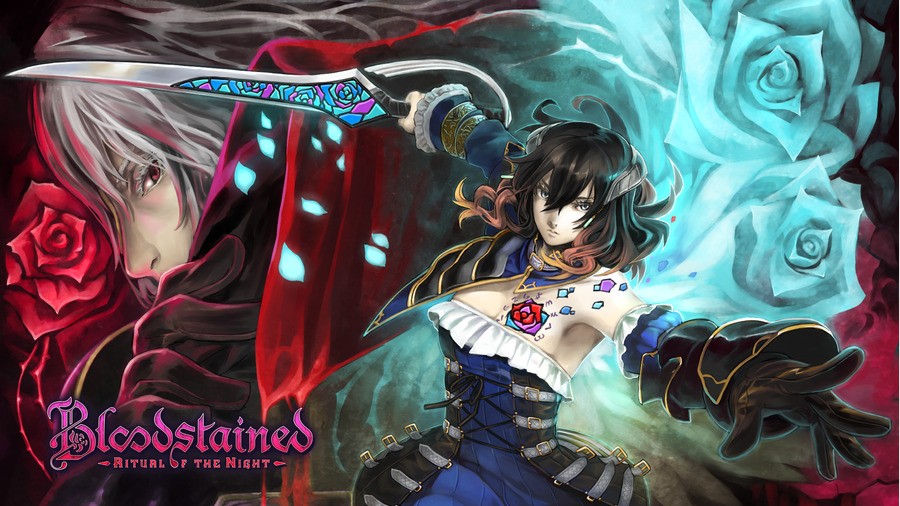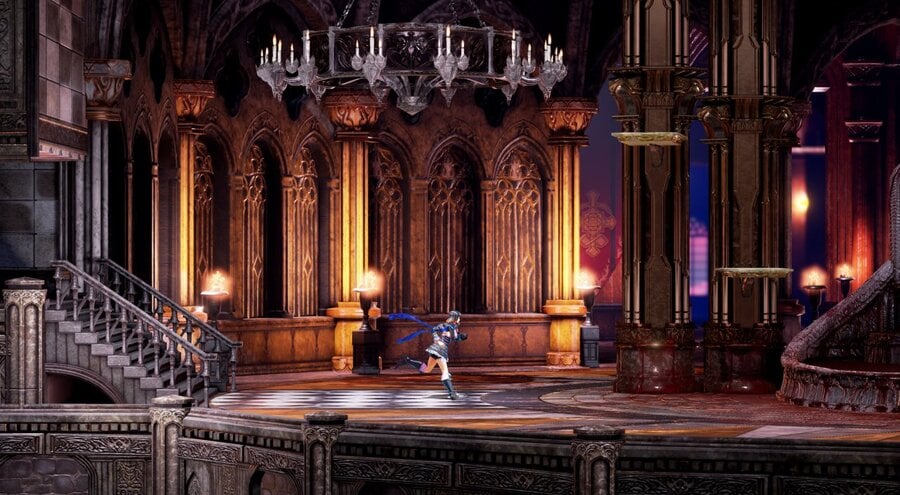
Back in 1997, Koji Igarashi made gaming history with the extremely successful Castlevania: Symphony of the Night. The reason that Castlevania shares half of the name with "Metroidvania", Symphony of the Night was lauded for its fantastic art direction and intricately designed castle. Later on, the formula established by this game was iterated upon and refined by two trilogies - one on GBA and one on DS - that largely carried the spirit of this game. And now, we're getting the unofficial seventh game.
What's immediately apparent about Bloodstained: Ritual of the Night is how instantly familiar it is to its predecessors. Miriam, the protagonist, controls and behaves almost exactly like a member of the Belmont clan and the stage design very closely resembles that of the Gothic halls that we all know and love. That all being said, this is a game that is setting out to craft its own identity, and it adds some subtle changes to the style of the gameplay and visuals in order to set itself apart.
In our demo we got to play through an opening scene of the game, wherein Miriam explores the Galleon Minerva as it's on route to the castle where the meat of the game will be taking place. The visuals are quite interesting, opting for a WayForward-esque look of what appear to be hand drawn characters moving on a 2D plane through a 3D world. Enemies can pop up on you from the foreground or background, so this extra space certainly isn't wasted. The environments are suitably moody and there's a nice level of attention to detail in the background; one portion of the demo saw us travelling across the deck of the ship, as a storm rages overhead and rain pours down from all directions. If there's one reservation to be had, it's that animations still seem to be a little stiff, but this will no doubt be ironed out before the end of development.

From a gameplay perspective it's a lot like previous Castlevania games. Timing is key with everything due to how there's a slight wind-up animation every time you attack, but this makes combat feel rather satisfying. Health and magic is largely handled the same way, too, though the difference here is that you collect shards to fuel special attacks rather than hearts. You can regularly swap out equipment and weapons for ones with better stats or a different playstyle, and you'll often be finding new stuff by felling enemies and looting treasure chests that you find around the world.
It seems that the Souls System from Castlevania: Dawn of Sorrow and Castlevania: Aria of Sorrow will be making a return, as well. Defeating enemies will occasionally cause Miriam to be impaled by shards which grant her new abilities, such as the power to shoot fire from her hands. If it's anything like the Souls System, this will definitely help to mix up the combat and keep things interesting.
At the end of the demo we got to experience a boss battle that gives us hope for what's in store for the rest of the game. On the deck of the ship we waged war against a gigantic, tentacled, Kraken-woman, which suitably matched the freakish nature of many of the enemies of previous Castlevania games. It was a joy learning the boss's patterns and figuring out when it was best to strike, so we greatly look forward to what will no doubt be some very memorable boss fights later on in the campaign.
All told, Bloodstained: Ritual of the Night is shaping up to be a worthy successor to the Castlevania games of yore. Tight gameplay, creepy environments and exploration are all present and accounted for in this early build, and it very much seems like this is the game that Koji Igarashi has been waiting to make for a long time. We're eagerly awaiting Bloodstained's March 2017 release; if the demo was any indication, this will certainly be one to remember.



Comments 56
No Mighty no 9 2?
Looking forward to this game! The castlevania games on the GBA and DS are great games, especially Aria of Sorrow (GBA) and Dawn of Sorrow (DS)!
Big fan of Metroidvania,
I really want to play this one
@Tsurii Me too, but at least there will be a physical Wii U version
This looks like the Castlevania games that were on DS. Nice!!! IGA rocks!!!
So, we have SotN, then "two trilogies" as stated in the article, and this is supposed to be the 'seventh' game? More like eighth.
Day 1 buy.
I wasn't excited about this until now. So far, so good.
really looking forward to this one
just hope it's not another Mighty No9
I was REALLY hoping for a 3DS release for this. 2 trilogies worth of Castlevania games on the handheld, then they cut me off cold turkey.
I like to pretend that the Castlevania game we DID get for 3DS was a fever dream I had, and it's not a real game.
Miriam is familiar apparently?
Sounds good so far, we'll see once more details roll in. Seems like Iga's managed to keep his "spiritual successor" track record on the rails so far.
If they do a decent Wii U version, insta-buy for me
I got the demo the other day and totally loved it. I think this could be a real winner after the disappointment of Mighty No. 9!
@NintendoFan4Lyf I'm in the exact same boat as you.. Or ship... Anyway yeah... I picked PS4 but I want it for Wii U ideally. Honestly the fact that it's at the end of its life is killing the decision for me. If I knew Wii U games would be backwards compatible with NX then I'd instantly spring for the Wii U version. Maybe some news will come out about backwards compatibility or whatever with NX and we can both make a good choice
I'd be more excited for this if I didn't have almost the entire Castlevania series in front of me, yet to be played. And I do plan to play it.
if those are 3d sctrolling backgropunds this game will look incredible. Cant wait! I liked Castlevania on 3DS 10 out of 10 and hopefully this is right up castlevania's alley. Does anyone Know if this is getting a Cartrdidge release or just Eshop Release?
Looks great. Haven't played a great new Castlevania game since Order of Ecclesia.
I'm glad this kickstarted game seems to be up to the standard that fans expect, can't wait to play it.
After Mighty 9's issues I got worried about this one, so this makes me feel better about it.
Looking forward to this.
... there's no 3DS version!?
@Desrever @Moon There will be a prologue game for the 3DS and Vita. Since this game is powered by Unreal Engine 4, putting it on the 3DS is difficult enough.
This looks really cool! To be honest, I've never really played a Castlevania game (other than the Mirror of Fate demo years ago on 3DS) or anything like it, but this game may change that.
@Smash_kirby Oh, interesting! Hopefully it's not really short and similar in length to the DS games. Is there any word on where it is in development?
This and Yooka-Laylee are my two most anticipated games for the coming year (other than Zelda and Final Fantasy 15).
@GrandpaPixel Physical release was confirmed after all?
I kind of like the movement animation. It looks slower and more floaty than other platformers, but Symphony of the Night is also slower and more floaty than other platformers. I think it lends itself well to a more methodical plan of attack rather than twitchy reflexes. But whatever way they go, I am really looking forward to this game. (^_^ )/
@bezerker99 the ones on the ds and gba copied the psone game. all great games. i wish the ds castlevania games would be on the wii u vc.
Wii U or PS4. I'll still get it
Looking good, that small little trailer was enough to win me over.
Looks so good, can't wait
PLEASE don't suck. Seriously! Just not terrible, that's all I ask!
@Tsurii The demo is avaliable since some backers distributed this demo on online sites.. The demo was really fun!
The demo was good. I think its shaping up very nicely.
@owendershot I'm a little worried about that as well. Hopefully, they won't push back the Wii U release, as other indie devs have done. I'd like for this and "Yooka-Laylee" to be a last hurrah of sorts for the Wii U - as I'll probably be getting "Breath of the Wild" on NX.
@Oubie Wish we'd get the DS trilogy on VC already. Haven't played any of them.
Oh mama, so ready for this game.
Never heard of it, this looks good! Where is a demo available?
@Oubie
Definitely! This game is the indie game i'm looking forward to most!
Looks like it could turn out really good. The needed to show some enemies in that demo though.
Glad I got this on kickstarter !
Going by the E3 demo videos around YouTube, this is shaping up quite nicely. I especially love the backgrounds, they are fantastic. My very favorite thing has to be Miriam's design, but in this early build her movements could still use some polish.
I also love the music.
Got this demo through the KS project a couple of days ago. For an early alpha, this definitely has the good ol' Castlevania feel to it. A nice little early birthday present
But it's going to be harder to wait for the 2017 official release.
It looks exactly what a Castlevania should look like. But that's just it. This isn't a spiritual successor, more of a copy and paste.
@Kenology Don't wait and go buy and play them on your DS or 3DS (if you have one haha)!
@Tempestryke Looks like a nice finish line for the Wii U with Bloodstained, Yooka-Laylee and of course Zelda early 2017!
@Oubie I do have a 3DS but I would rather own them digitally. So I'm holding out for Konami making them available on VC, as unlikely as that is now. But if it isn't going to happen, I'll track down physical copies.
@Kenology Ah okay. I just love the look of the box and smell of the manual haha
@Oubie indeed it does.
All of these people on here who have only played Mercurysteam's 3DS game are freaking me out. Go find SYMPHONY OF THE NIGHT, CIRCLE OF THE MOON, either of the SORROW entries, and/or ORDER OF ECCLESIA. DO IT NOW!!!!!
Cannot wait for bloodstained it looks great
https://www.nintendolife.com/forums/wiiu_eshop/koji_iga_igarashi_and_rumored_2d_castlevania_type_game6
if anyone wants to join in...
@WhiteTrashGuy
dont forget portrait of ruin. all 7 of these games are crazy awesome
@Oubie Me too. But nowadays I need to reduce clutter. I have so many NES, SNES, N64, Gamecube, DS, 3DS, Wii, and Wii U games lying around I'm trying to go digital with what I can (especially older games) and sell my physical copies.
@Kenology I sadly stopped one day with my old collection because I just don't have any space left in my rental apartment. Sold my N64, GameCube, PS2, DS and Wii. Kept soms physical games from the DS and Wii as they're playable on my 3DS and Wii U. And the Virtual Console is keeping my NES, SNES, N64, GB and GBA games alive
Tap here to load 56 comments
Leave A Comment
Hold on there, you need to login to post a comment...